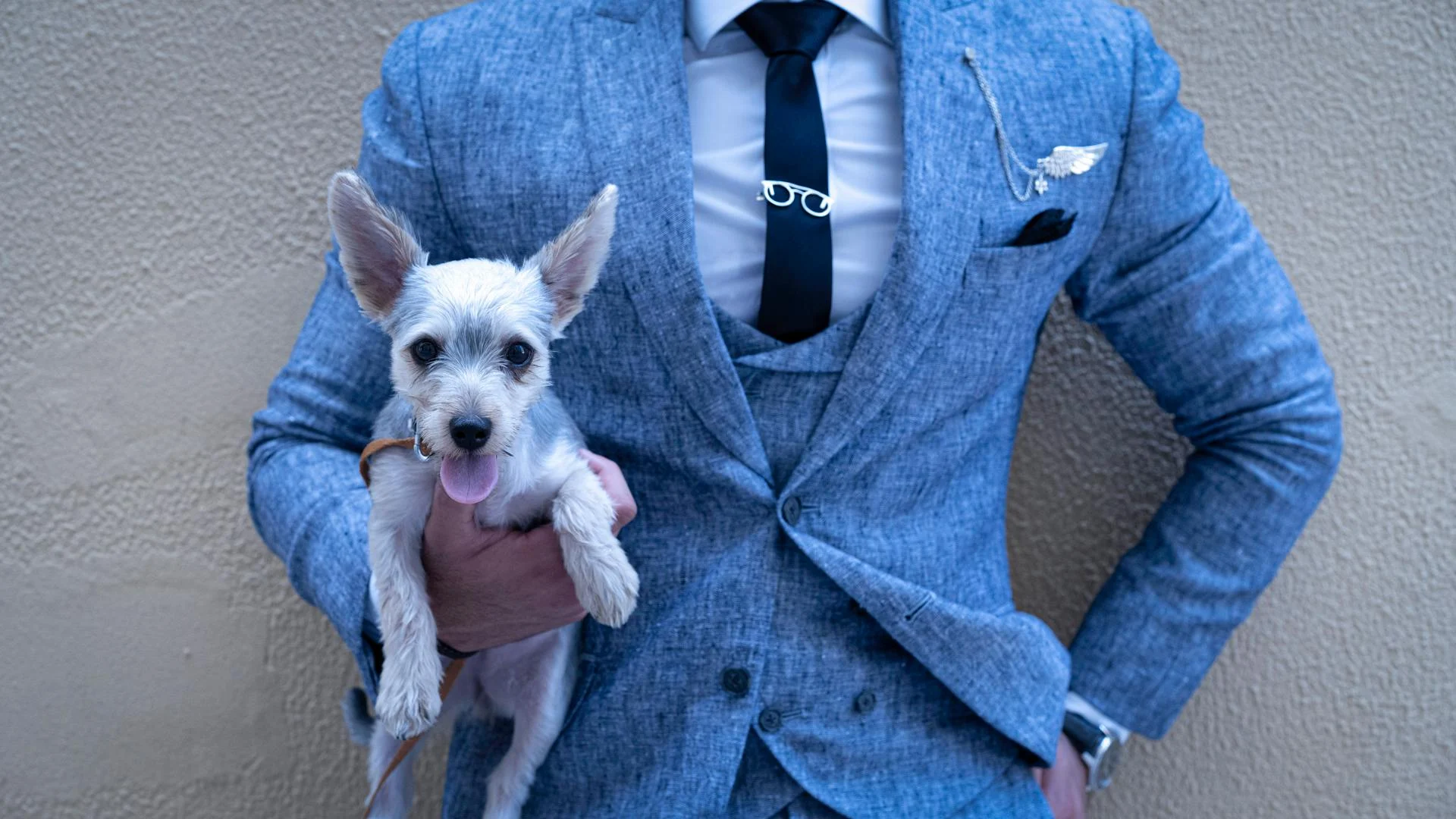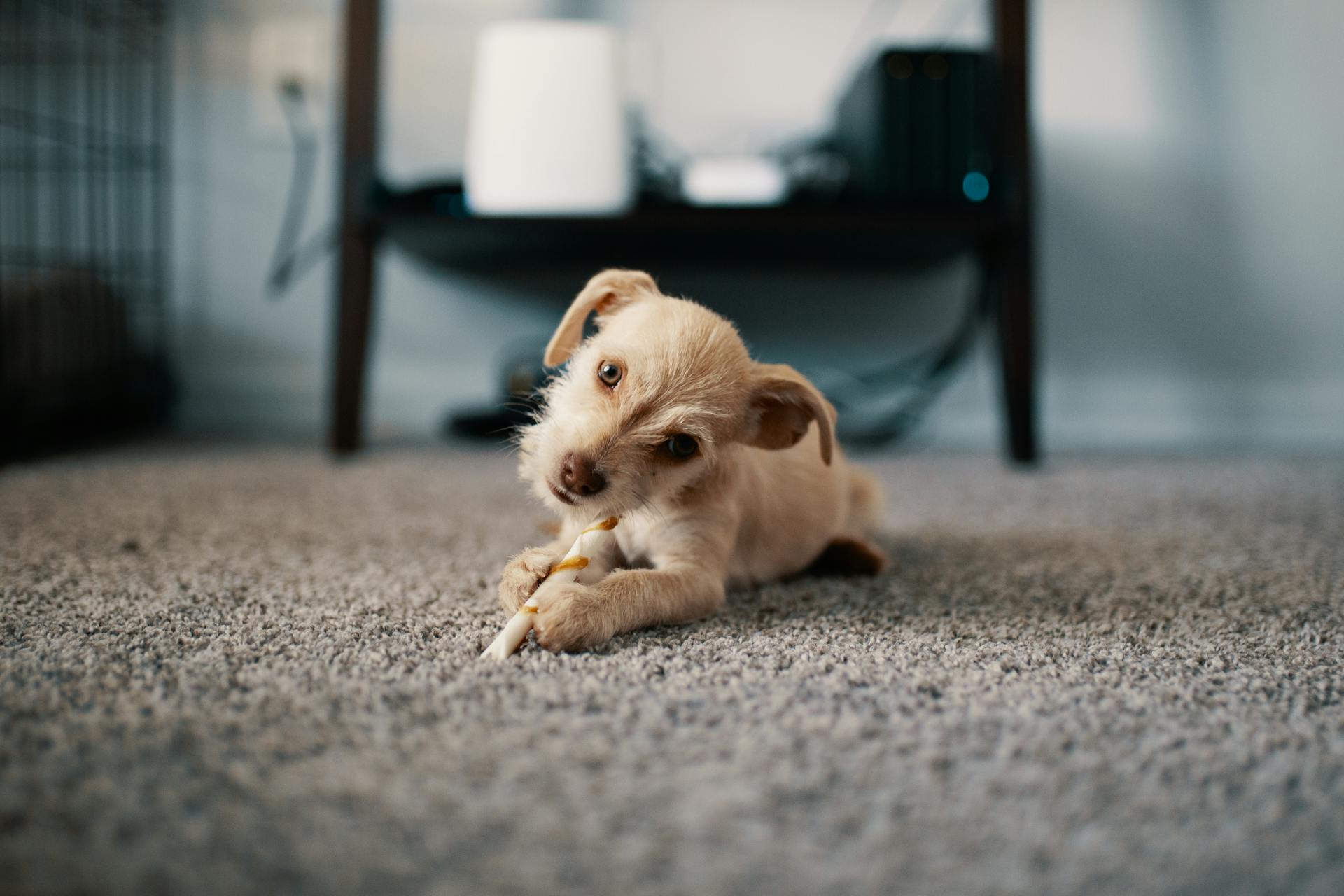
The Swedish Vallhund is a small herding dog that originated in Sweden, where it was bred to herd cattle and sheep. They're a compact dog with a sturdy build.
This breed is known for its short stature, typically standing between 10-14 inches tall. They have a short, dense coat that requires regular grooming.
Their energy level is moderate to high, requiring daily exercise to keep them happy and healthy. A 30-minute walk or playtime should suffice.
History and Origin
The Swedish Vallhund is an ancient breed with a rich history that spans over 1,000 years. They originated in Sweden, specifically in the province of Västergötland, where they were used for herding, guarding, and companionship.
Their name, Vastgotaspets, translates to "small Spitz of the West Goths", which is a region of Sweden. This name gives us a glimpse into their origins and the importance they held in their native country.
The breed's exact origin is still a mystery, but it's believed that they may have descended from dogs owned by Vikings. Some theories even suggest that they could have played a part in the development of the modern Welsh Corgi and the Lancashire Heeler.
On a similar theme: Dog Sledding Name
The Swedish Vallhund is related to larger spitz-type dogs and moosehunting dogs of Scandinavia. In fact, large dogs of this type have been found buried with their masters in Stone-Age settlements in Scandinavia.
Here are some key facts about the Swedish Vallhund's history and origin:
- They date back to the 8th or 9th century.
- They originated in the province of Västergötland, Sweden.
- They were used for herding, guarding, and companionship.
- They may have descended from dogs owned by Vikings.
- They are related to larger spitz-type dogs and moosehunting dogs of Scandinavia.
The breed was first recognized by the Swedish Kennel Club in 1943, and it wasn't until the 1970s that they were introduced to the UK. Today, they are prized as loyal and affectionate companions, making them a popular choice for families and individuals alike.
Characteristics of the
The Swedish Vallhund is a breed that's full of energy and loves to play. They're known for their high energy level, which helps shape their personality and makes them a joy to be around.
Their temperament is generally sociable and sweet, making them a great addition to families. They're also highly intelligent and trainable, which is a big plus for first-time dog owners.
Suggestion: Are Border Collies High Energy
One thing to keep in mind is that Swedish Vallhunds are high-energy dogs that require regular exercise to stay happy and healthy. They need plenty of physical and mental stimulation to prevent boredom and destructive behavior.
Here are some key characteristics of the Swedish Vallhund breed:
Overall, the Swedish Vallhund is a loyal and loving companion that thrives on attention and activity.
Appearance and Gait
The Swedish Vallhund is a sturdy and agile breed, with a unique appearance that sets it apart from other dogs. They have a long, powerful body, typically measuring between 31-35 cm in height.
Their wedge-shaped head is one of their most distinctive features, with dark brown oval eyes and pricked ears. The ears are moderately large and pointed, with hard leathers that add to their overall appearance.
A Vallhund's muzzle is rather square, being a little shorter than their skull, and they have strong, powerful lower jaws and well-defined facial masks. Their necks are well-muscled and long, allowing for a good reach.
Their coat is moderately long, harsh, and close lying, with a softer undercoat. The accepted breed colours for Kennel Club registration include a variety of shades, including grey, red, and sable.
Here are the accepted breed colours for Kennel Club registration:
- Grey
- Grey & White
- Grey Brown
- Grey Sable
- Grey Sable & White
- Greyish Yellow
- Red
- Red Sable
- Reddish Brown
- Reddish Yellow
- Sable
- Steel Grey
- Wolf Grey
Their gait is free and energetic, with their front legs well extended and their hindquarters showing a tremendous amount of power.
Discover more: Dogs Breeds That Start with B
Appearance of the
The Swedish Vallhund is a sturdy breed with a unique appearance. They have a long, powerful body, similar to a Welsh Corgi.
Their height at the withers is quite specific: males range from 33 to 35 cm, while females are between 31 and 33 cm. This makes them a relatively compact breed.
Their heads are quite long and clean-cut, with well-defined stops that give them a wedge-shaped appearance when viewed from above. Their muzzles are square and slightly shorter than their skull.
Strong, powerful lower jaws and well-defined facial masks add to their distinctive appearance. They have tight lips and black noses.
Their oval-shaped eyes are a very dark brown, and their ears are moderately large and pointed. Dogs have hard leathers from the base of their ears to the tips.
The Vallhund has a perfect scissor bite, where their upper teeth closely overlap their lower ones.
Their necks are well-muscled and long, allowing them to have a good reach. Their forequarters are powerful, with long, well-laid-back shoulder blades and upper arms that are slightly shorter than their shoulder blades.
Their forearms are slightly bent when viewed from the front, but straight when seen from the side. Their legs show a good amount of bone and are strong.
Here are the accepted colours for Kennel Club registration:
- Grey
- Grey & White
- Grey Brown
- Grey Sable
- Grey Sable & White
- Greyish Yellow
- Red
- Red Sable
- Reddish Brown
- Reddish Yellow
- Sable
- Steel Grey
- Wolf Grey
Their coats are moderately long, harsh, and close-laying, with a softer, woollier undercoat.
Gait/Movement
The Vallhund's gait is a true marvel to behold. It's a free and energetic action that showcases their incredible athleticism.
Their front legs are well extended without being raised too high, giving them a unique and distinctive stride.
Males should have both testicles fully descended into their scrotums, which is an essential aspect of their physical health.
A Vallhund can be slightly taller or shorter than the breed standard, and they can also be a little lighter or heavier, but these variations are perfectly normal.
Temperament and Personality
The Swedish Vallhund is an intelligent and energetic dog that thrives on mental stimulation and daily exercise. They need to be trained and handled by people who understand their needs.
These dogs are highly confident and outgoing by nature, making them excellent herding and guarding dogs. Their strong protective instincts also make them great guard dogs.
Swedish Vallhunds are best suited to active families who can provide them with plenty of exercise and attention. They are not the best choice for first-time owners or those who live in small apartments.
They have a strong instinct to herd and may dig, chase wildlife, or attempt to herd other pets and children. Early socialization is crucial to prevent shyness or anxiety in these dogs.
A well-socialized Swedish Vallhund is a loyal and courageous companion who will alert their family to any strangers or perceived dangers. They are also known to be vocal and may bark to chat with their owners or alert them to something.
Their intelligence and love of problem-solving make them great at figuring out complicated interactive toys. With consistent training and early socialization, Swedish Vallhunds can become well-rounded and happy dogs.
For your interest: Shiba Inu Owner
Temperament of the
The Swedish Vallhund is a confident and outgoing dog that thrives on mental stimulation and daily exercise. They need to be trained and handled by people who understand their needs.
They are extremely intelligent and love to learn, especially if you make it fun for them. This makes them highly amenable to learning new things.
However, they can also be quite vocal, especially if there are strangers about or when something they don't like is going on in their environment. Vallhunds can be taught to "speak" on queue.
They have a strong protective instinct, making them excellent guard dogs. But this also means they may dig, chase wildlife, or attempt to herd other pets and children.
Their herding heritage makes them naturally inclined to nip at fast-moving objects, which can be a problem if not corrected early on. A stern "No" every time you see this behavior will help them learn what's acceptable.

Early socialization is crucial for Vallhunds, ideally before they're four months old. This helps them grow into confident, outgoing dogs that are unafraid of strangers, children, and other animals.
Their independence can make them harder to live with if they don't know who the alpha dog is in the household. Consistent training and leadership will help establish their place in the pack.
Prey Drive
Vallhunds have a high prey drive due to their working and hunting dog lineage. They're social by nature, but this strong instinct can get them into trouble if not managed properly.
If you live near areas with livestock or wildlife, it's crucial to keep a close eye on your Vallhund when they're off the lead. This will prevent any potential harm to the animals and your dog.
Their strong prey drive can lead to unwanted behaviors like chasing small animals, so it's essential to provide them with plenty of exercise and mental stimulation to keep them satisfied.
Additional reading: How Strong Are German Shepherds
Separation Anxiety
Separation anxiety is a common issue in Vallhund households. Vallhunds form strong ties with their families and dogs are never very happy when they find themselves left on their own for longer periods of time.
Leaving a Vallhund alone for extended periods can lead to destructive behavior around the home. This is a dog's way of relieving any stress they are feeling and a way to keep themselves entertained.
Vallhunds are better suited to people who either work from home or in households where one person stays at home when everyone else is out.
See what others are reading: German Shorthaired Pointer Free to Good Home
Care and Feeding
Swedish Vallhund puppies are full of energy and love to play, so it's essential to puppy-proof your home and garden before bringing one home. This means putting away any tools or implements that could harm them and keeping electric wires and cables out of reach.
Puppies need to sleep a lot to grow and develop, so it's crucial to set up a quiet area where they can retreat to when they want to nap. You should also try to keep "playtime" calm inside the house and reserve more active play for outside.
To ensure your puppy grows and develops as they should, it's essential to feed them a highly nutritious diet. As a rough guide, a Vallhund puppy can be fed the following amounts every day, making sure their meals are evenly spread out throughout the day:
Puppy Care
Puppy care is a top priority for any new dog owner. To ensure your Swedish Vallhund puppy grows and develops properly, it's essential to provide a safe and nurturing environment.
Puppies need to be wormed at specific intervals, with the first worming at 6 months old, followed by wormings at 8, 10, and 12 months old. This schedule is crucial for their health and well-being.
To keep your puppy safe, it's crucial to puppy-proof your home and garden. This means removing any hazardous items, securing toxic plants, and blocking off areas you don't want your puppy to access.
Puppies need plenty of sleep to grow and develop, so it's essential to set up a quiet area for them to retreat to when they need a nap. Disturbing a sleeping puppy can be stressful for them, so it's best to let them sleep undisturbed.
Recommended read: Do Border Collies Need to Be Groomed
A good quality puppy bed is a must-have for your furry friend. Look for a bed that's not too small or too big, and make sure it's comfortable and supportive.
To keep your puppy's coat healthy and shiny, you'll need to brush them regularly. A slicker brush or soft bristle brush is ideal for Swedish Vallhunds, and a grooming glove can help remove loose hair and distribute skin oils.
Here's a list of essential items you'll need for your puppy:
- Good quality puppy or baby gates to fit on doors
- A good well-made playpen that's large enough for a puppy to play in
- Lots of well-made toys, including good quality chews suitable for puppies
- Good quality feed and water bowls, ideally ceramic
- A grooming glove
- A slicker brush or soft bristle brush
- Dog specific toothpaste and a toothbrush
- Scissors with rounded ends
- Nail clippers
- Puppy shampoo and conditioner specifically formulated for dogs
- A well-made dog collar or harness
- A couple of strong dog leads
- A well-made dog bed that's not too small or too big
- A well-made dog crate for use in the car and in the home
- Baby blankets for your puppy's crate and bed
Feeding your puppy a high-quality diet is crucial for their growth and development. Aim to feed 2-3% of your puppy's body weight in food per day, divided into 3-4 meals. Here's a rough guide to the daily feeding amounts for your Swedish Vallhund puppy:
Remember to always consult with your veterinarian for personalized feeding recommendations and to discuss any concerns you may have.
Spaying and Neutering
Many vets recommend waiting until dogs are slightly older before spaying and neutering them, so they can be more mature before undergoing the procedures.
Some vets advise neutering males and spaying females when they are between the ages of 6 to 9 months old, and sometimes even when a dog is 12 months old.
Other vets recommend spaying and neutering dogs when they are 6 months old, but never any earlier unless for medical reasons.
It's essential to discuss spaying and neutering with a vet and follow their advice, as many breeds are different and may require unique considerations.
Curious to learn more? Check out: 4 Months Dogo Argentino Puppy
Do They Like Water?
Vallhunds love swimming and will take to the water whenever they can, especially on hot days.
They're natural swimmers, but it's essential to remember that some Vallhunds may not like water as much as others.
Care should always be taken when walking a Vallhund off the lead near watercourses, as they may decide to leap in and need rescuing if they can't get out on their own.
If your Vallhund doesn't like water, never force them to go in, as it could end up scaring them.
Frequently Asked Questions
Are Swedish vallhunds good family pets?
Swedish Vallhunds are a great fit for active families who can provide plenty of exercise and mental stimulation. However, they may not be suitable for busy families who can't meet their energetic needs
Are Swedish vallhunds rare?
Yes, Swedish Vallhunds are a rare breed. They are one of the less common Spitz breeds, making them a unique and special companion.
Do Swedish vallhunds bark a lot?
Yes, Swedish Vallhunds are known to be vocal and bark frequently, making them decent watchdogs but also potentially noisy pets. With proper training, you may be able to reduce excessive barking, but it's unlikely they'll become completely quiet.
How much does a Swedish Vallhund cost?
A Swedish Vallhund can cost between $500 and $2,000, depending on whether it's a pet-quality or show-quality dog. Prices vary based on appearance, but all dogs make great pets.
How to get a Swedish Vallhund?
To get a Swedish Vallhund, you'll need to find a reputable show breeder who specializes in breeding dogs for the show ring. They will be able to match you with a puppy that meets the breed standard.
Featured Images: pexels.com


